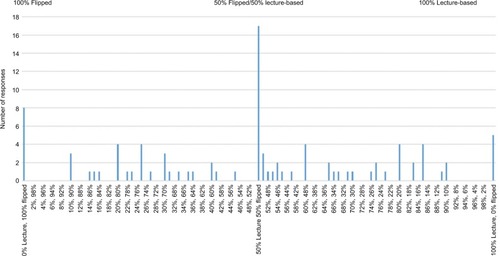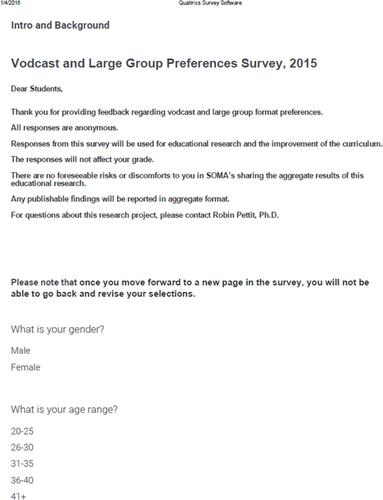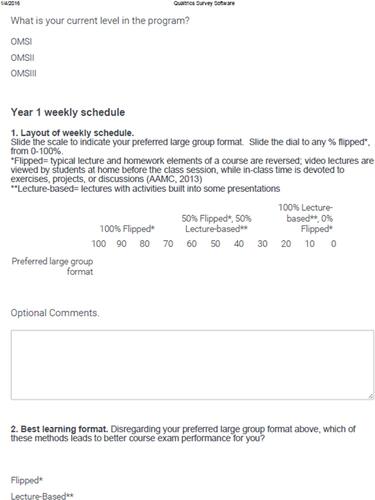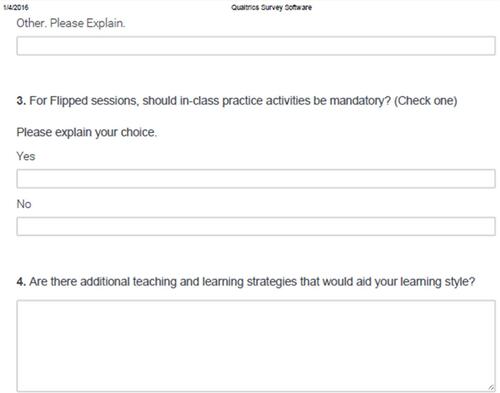Abstract
Flipped instruction is gaining popularity in medical schools, but there are unanswered questions such as the optimum amount of the curriculum to flip and whether flipped sessions should be mandatory. We were in a unique position to evaluate feedback from first-year medical students who had experienced both flipped and lecture-based courses during their first semester of medical school. A key finding was that the students preferred a variety of different learning formats over an “all or nothing” learning format. Learning format preferences did not necessarily align with perceptions of which format led to better course exam performance. Nearly 70% of respondents wanted to make their own decisions regarding attendance. Candid responses to open-ended survey prompts reflected millennial preferences for choice, flexibility, efficiency, and the ability to control the pace of their learning, providing insight to guide curricular improvements.
Introduction
Most of today’s medical students are millennial or Generation Y learners.Citation1 Millennials expect choice, flexibility, speed, and efficiency.Citation2 They are usually attentive learners if the format is on their own terms,Citation3 and they can control the pace, sequence, and content.Citation4 Millennials are technology savvy and often prefer to learn by trial and errorCitation5 and by doing,Citation4 both major components of the flipped classroom.Citation6
In a flipped classroom, typical lecture and homework elements are reversed; recorded lectures, vodcasts (video podcasts), or readings are viewed by students prior to class, while in-class time is devoted to more student-centered activities.Citation6 Various medical schools have reported their experiences in flipping courses, disciplines, and even entire curricula.Citation7–Citation13 While other medical schools have compared student satisfaction with flipped instruction to cohorts from previous years who experienced traditional instruction,Citation7,Citation11 we had the ideal environment to obtain input regarding both strategies from a single cohort. This cohort experienced a pilot flipped course followed by four traditional courses in their first semester of medical school.
Evaluation of instructional methods should address learner beliefs and preferences.Citation14,Citation15 With this in mind, the aim of this study was to identify stakeholder preferences prior to curricular changes, with the goal of increasing opportunities for student learning. The following research questions were posed: Do first-year medical students (MS1s) prefer flipped or lecture-based formats or a combination of approaches? Which format do they think helps them learn better? What are students’ obstacles to mandatory attendance for flipped activities? Are there additional teaching strategies that would aid their learning styles?
Methods
Participants and setting
The first course of the year for the class of 2019 (MS1s) was a pilot 3-week anatomy course, Basic Structural Foundations, in which 75% of the content was flipped and the other 25% was lecture-based with embedded activities. For flipped sessions, students viewed vodcasts containing interactive quizzes prior to coming to class for non-mandatory practice activities. The next four courses were lecture-based, ~70% of these with built-in activities, and a small percent (5%) flipped with vodcasts. Activities for flipped sessions and lecture-based sessions varied widely, from drawing anatomical structures to games to case presentations (McCoy et al, manuscript in preparation).
Development of the survey instrument
An original, four-item, interactive, electronic Qualtrics™ survey (Figure S1) was used to gather student feedback on flipped learning. Two questions at the beginning of the survey addressed age range and gender.
Data collection
MS1s were surveyed in January 2016 after completing the five courses described earlier. Survey data collection involved an email solicitation containing a clickable link to the online survey. Survey participation was voluntary and anonymous, and there were no rewards offered for completing the survey. Completion of the survey was deemed consent. The A. T. Still University Institutional Review Board (IRB) deemed the study exempt from IRB reporting requirements for human subjects research because no collected data associated directly through identifiers linked to participants and was conducted via anonymous surveys.
Data analysis
We used open- and axial codingCitation16 to analyze students’ responses to open-ended survey prompts.
Results
Survey response rate and demographics
A total of 104 students (91.0% response rate) participated in the survey. There were 54 male and 50 female respondents (65 aged 23–25 years, 31 aged 26–30 years, 7 aged 31–35 years, and 1 aged 37 years).
Do MS1s prefer flipped, lecture-based formats or a combination of approaches?
A major unanswered question for educators implementing the flipped method is the optimum amount of the curriculum to flip. We probed this topic with the following interactive survey question: “Slide the scale to indicate your preferred large group format”. The preferred large group format for 18% of respondents (n=94) was 50% flipped/50% lecture based (). There was tremendous variation in preferred pedagogical approach for the rest of the students. Indeed, the histogram in shows a peak at 50% flipped/50% lecture based, with the remaining responses distributed almost equally on either side.
Figure 1 Summary of student responses to the prompt, “Slide the scale to indicate your preferred large group format. Slide the dial to any % flipped, from 0% to 100%.”

Twenty students provided optional comments regarding their preferred large group format. When these comments were categorized using open and axial coding,Citation16 six key themes emerged: Pace, Organization, Discipline-specific, Schedule/Echo360™ (lecture capture technology), Suggestions to enhance lecture-based with activities, and Independent study (). Some comments reflected perceived drawbacks to the flipped method in terms of Pace and Organization. For example, one comment exemplified the millennial desire to control the pace of their learning: “People work at different paces, and flipped classrooms encourage rushed learning, especially when people blurt out answers, it makes you feel behind and inadequate” (theme Pace). Comments that are coded with Discipline-specific and Schedule/Echo360 provided suggestions for selective use of the flipped method and illustrate the millennial preference to control the content and sequence of their learning, including “This really depends on the subject matter. For me, I like flipped for anatomy and micro courses as there is simply a bunch to memorize and the podcasts/vodcasts do a good job of this tedious stuff and then in class activities for what we learned. However, courses like physiology, biochemistry, genetics, I prefer regular lectures given in class” (theme Discipline-specific) and “Enjoy flipped classroom, however would prefer if they occur earlier in the week so there is enough time over the weekend to prepare for those classes” (theme Schedule/Echo360). Three comments that are coded with the theme Suggestions to enhance lecture-based with activities were supportive of preview videos (short vodcasts on basic concepts), which were provided in advance of some biochemistry and genetics lectures. A few students indicated their preference for other methods of receiving information (theme Independent study), including reading.
Table 1 Summary of student responses to optional comments regarding preferred large group format
Which pedagogical format do MS1s think helps them learn better?
The follow-up survey prompt was “Best learning format. Disregarding your preferred large group format above, which of these methods leads to better course exam performance for you?” Of the 17 students who selected 50% lecture/50% flipped as their preferred large group format, six thought that flipped formats led to better course exam performance, five thought that lecture led to better course exam performance, and six selected “other”, explaining that either a combination or some alternate method (eg, study groups) worked best. For the remaining students, ie, those who selected a combination other than 50% lecture/50% flipped, 75.9% perceived that their selected method led to better exam performance, 19% perceived that the opposite of their preferred modality led to better exam performance, and 5.1% chose “other”, explaining that either a combination or some alternate method led to better exam performance.
What are MS1 obstacles to mandatory attendance for flipped activities?
Another unanswered question regarding flipped learning is whether in-class activities should be mandatory. When the preclinical curriculum was flipped at one medical school, student attendance and engagement were lower than expected,Citation13 which was partially attributed to non-mandatory attendance.Citation17 Our medical school does not currently require attendance for lecture-based and flipped sessions, but lectures are recorded via lecture capture.
In this study, 68.7% of respondents thought that in-class practice activities for flipped sessions should be non-mandatory. Their responses to the follow-up prompt, “Please explain your choice” coded into seven key themes: Learning style, Attitude/Preferred learning conditions, Not efficient, Choice, Lack of preparation/time, Situation-dependent, and Pace (). Many of these themes and associated comments aligned with millennial expectations for choice, flexibility, efficiency, and the ability to control the pace of their learning.Citation2 For example, the millennial desire for choice was exemplified by the comment “People should have the choice if they want to use in-class activities or their own activities to strengthen their understanding of material” (theme Choice). The millennial desire to control the pace of their learning was exemplified by the comment “I like practice activities but I do sometimes feel like I take a backseat in group work. Other people come up with answers and I feel like I do not have as much time to work through problems on my own” (theme Pace). Two enlightening comments under the theme Attitude/Preferred learning conditions were “When people are required to attend but do not actually want to be there, it ruins it for those of us who do want to attend” and “I like when it is less crowded.”
Table 2 Summary of student responses to the open-ended prompt, “Please explain your choice”, that followed “For flipped sessions, should in-class practice activities be mandatory?”
Nearly one-third of respondents (31.3%) indicated that flipped learning sessions should be mandatory. Their responses to the follow-up prompt “Please explain your choice” coded into six key themes: Motivation to attend, Motivation to stay on top of material, Application of knowledge, Promotes learning, Activity enhanced with increased participation, and Situation-dependent (). Motivation to attend, Motivation to stay on top of material, and Situation-dependent were the most common themes. An unexpected comment that was coded with Motivation to attend was “Non-mandatory makes the material feel unnecessary.” Other valuable perspectives included “For many activities having more participants makes the activity more enriching (such as competitive games)” (theme Activity enhanced with increased participation). Well-structured activities, a critical component of a successful flipped class, were important to both group of students, those who supported non-mandatory attendance (, theme Situation-dependent) and those who supported mandatory attendance (, theme Situation-dependent).
Table 3 Summary of student responses to the open-ended prompt, “Please explain your choice”, that followed “For flipped sessions, should in-class practice activities be mandatory?”
Are there additional teaching strategies that would aid their learning styles?
In response to the prompt, “Are there additional teaching and learning strategies that would aid your learning style?”, 11 categories emerged: Incorporation of more practice questions, including clicker questions (16% of respondents); Larger formative quizzes (12% of respondents); Review sessions (4% of respondents); Cumulative exams (2% of respondents); Independent study (6% of respondents); Group study (2% of respondents); Vodcast transcripts (4% of respondents); Board preparation including professors “referencing First Aid pages” (4% of respondents); Inclusion of external vodcast sources (4% of respondents); Mandatory individual small group preparation so that students “can rip through as many cases as we can in the time given” (2% of respondents); and Large group strategies including “organized PowerPoints”, “tons of examples”, “games”, “more models”, “connecting lecture material”, “small groups where we draw physiologic processes with peers to demonstrate our understanding”, and “presentations that touch on a variety of learning styles” (44% of respondents).
Discussion
While student preference does not necessarily equate to what approach is best for student learning, millennials are more likely to be attentive learners if the format is on their own terms.Citation3 In addition, health science student engagement has been shown to positively influence academic achievement.Citation18 As such, stakeholder feedback regarding the two most implemented pedagogical approaches (flipped or lecture-based), including student suggestions for optimizing them, will be considered during curricular improvements.
One of the most surprising results was the relatively large number of students who preferred >50% lecture-based classes. This finding was unexpected for several reasons: the high ratings MS1s gave the pilot flipped course, and millennial preferences for collaborative learningCitation1 and learning by doing.Citation4 These student preferences may have been influenced by the fact that most lectures had some active learning component or that lecture was perceived to be more efficient than the flipped method.Citation19 A small percent of the respondents wanted 100% lecture, a finding that other medical schools have reported.Citation7,Citation11 In addition to the insights provided by our students, possible explanations for lecture preference include undergraduate experience, rock concert “event-ness” making the material memorable,Citation20 the auditory-dominant learning mode of high-risk medical students,Citation21 and students’ perceived misalignments between active learning and national board exams.Citation19 Methods to engage students with a preference for lecture should be investigated, including those suggested by our students under Large group strategies (“Results” section).
Another unexpected result was that large group learning format preference did not always align with perceptions of which format led to better course exam performance. Rigorous studies are needed to determine if discrepancies between preferred learning format and actual outcomes are significant.
Student attendance requirements are the subject of ongoing debate in the medical education community. The availability of lecture capture technology has increased the number of students who choose not to attend class. For students in this study, obstacles to mandatory attendance were largely focused on choice, flexibility, speed, efficiency, and control of the format and pace of their learning; all well-known millennial expectations.Citation2–Citation4 While our faculty discuss the merits and drawbacks of particular attendance policies, we are incorporating MS1 suggestions to make flipped sessions efficient, high yield, and of broad appeal, and are providing enough time in the curriculum for students to prepare for these sessions. The hope is that these efforts will motivate students to attend and potentially increase their learning.
MoffettCitation22 suggested that a flipped learning approach does not have to be “all or nothing,” and only a minority of our students preferred all or nothing. In fact, the range of individual preferences for pedagogical approach was striking. Millennials were raised in an entertainment-focused, multi-media environment; as a result, they have a low tolerance for boredom.Citation23 Lack of pedagogical variety has the potential to cause boredom and to negatively impact students who do not perceive that they learn with the pedagogical method being implemented. In this study, the need for faculty to accommodate varied learning styles was evident throughout survey responses, lending further support to the important role of variety in the medical school curriculum.Citation10,Citation24,Citation25
A recent study provided evidence that the benefits of the flipped model are simply due to the active learning component.Citation26 As such, our results may have been influenced by the fact that ~70% of our lecture-based large group presentations have an active learning component.
Limitations
This research is limited by the institutional and cultural contexts in which it was conducted. Surveys were collected anonymously to reduce the likelihood of response bias. We were not able to characterize non-responders, who may or may not have had different perceptions of pedagogical approach. These students were in their first year of medical school, which may have influenced perceptions. The results of this study might not be generalizable to other educational programs or cultures. In an attempt to apply these methods and findings in a different context, investigators should consider the specific constraints, type of learning, outcome measures used, and the natural environment of the study setting.
Supplementary material
Disclosure
The authors report no conflicts of interest in this work.
References
- EvansKHOzdalgaEAhujaNThe medical education of generation YAcad Psychiatry201640238238526283527
- Western Michigan University [webpage on the Internet]How Are Millennial Students (and Faculty) Different from Previous Generations? Available from: http://www.med.wmich.edu/how-are-millennial-students-and-faculty-different-previous-generationsAccessed December 19, 2016
- BorgesNJManuelRSElamCLJonesBJDifferences in motives between Millennial and Generation X medical studentsMed Educ201044657057620604853
- TwengeJMGenerational changes and their impact in the classroom: teaching generation meMed Educ20094339840519422486
- MangoldKEducating a new generation teaching baby boomer faculty about millennial studentsNurse Educ200732212317220763
- EDUCAUSE7 Things You Should Know About…Flipped Classrooms Available from: https://net.educause.edu/ir/library/pdf/eli7081.pdfAccessed November 2, 2016
- EvansKHThompsonACO’BrienCAn innovative blended preclinical curriculum in clinical epidemiology and biostatistics: impact on student satisfaction and performanceAcad Med201691569670026796089
- HernandezMBrownJFosterJA flipped-classroom model that integrates basic and clinical sciences in a new medical school: the first 2 years at the Alabama College of Osteopathic MedicineMed Sci Educ201626181184
- MortonDAColbert-GetzJMMeasuring the impact of the flipped anatomy classroom: the importance of categorizing an assessment by Bloom’s taxonomyAnat Sci Educ201710217017527427860
- SharmaNLauCSDohertyIHarbuttDHow we flipped the medical classroomMed Teach201537432733024934251
- StreetSEGillilandKOMcNeilCThe flipped classroom improved medical student performance and satisfaction in a pre-clinical physiology courseMed Sci Educ2015253543
- SzarekJLBoardmanJMWhiteMHoltJTIntegrated and flipped: 5 years’ experience of integrating active learning in an integrated courseMed Sci Educ201626159167
- WhiteCBradleyEMartindaleJWhy are medical students ‘checking out’ of active learning in a new curriculum?Med Educ201448331532424528466
- VermettenYJVermuntJDLodewijksHGPowerful learning environments? How university students differ in their response to instructional measuresLearn Instr200212263284
- RobertsDHNewmanLRSchwartzsteinMTwelve tips for facilitating Millennials’ learningMed Teach20123427427822288944
- CorbinJStraussABasics of Qualitative Research: Techniques and Procedures for Developing Grounded TheoryThousand Oaks, CASage Publications2010
- WhiteCMcCollumMBradleyEChallenges to engaging medical students in a flipped classroom modelMed Sci Educ201525219222
- Casuso-HolgadoMJCuesta-VargasAIMoreno-MoralesNLabajos-ManzanaresMTBarón-LópezFJVega-CuestaMThe association between academic engagement and achievement in health sciences studentsBMC Med Educ2013133323446005
- WallingAIstasKBonaminioGAMedical student perspectives of active learning: a focus groupTeach Learn Med201729217318028033488
- RysavyMChristinePLenochSPizzimentiMAStudent and faculty perspectives on the use of lectures in the medical school curriculumMed Sci Educ201525431437
- JohnsonMEvaluation of learning style for first year medical studentsIntl J Scholarship Teach Learn20093
- MoffettJTwelve tips for “flipping’ the classroomMed Teach20153733133625154646
- RoehlingPVVander KooiTLDykemaSQuisenberryBVandlenCEngaging the millennial generation in class discussionsColl Teach20115916
- LujanHLDiCarloSEFirst-year medical students prefer multiple learning stylesAdv Physiol Educ2006301131616481603
- PettitRKMcCoyLKinneyMSchwartzFNStudent perceptions of gamified audience response system interactions in large group lectures and via lecture capture technologyBMC Med Educ2015159210.1186/s12909-015-0373-725997953
- JensenJLKummerTAd M GodoyPDImprovements from a flipped classroom may simply be the fruits of active learningCBE Life Sci Educ2015141112




